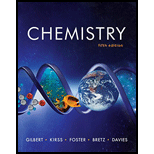
Concept explainers
Interpretation: The titration curve of a weak and a strong acid with a strong base is give. The curves are to be defined with the correct titration representation.
Concept introduction: The relative
To determine: The titration curve that corresponds to the titration of weak acid and that corresponding to the titration of strong acid.
Answer to Problem 16.1VP
Solution
The titration curve that corresponds to the titration of weak acid and that corresponding to the titration of strong acid is red and blue curve, respectively.
Explanation of Solution
Explanation
The titration graph representing the titration of a weak and a strong acid with a same strong base is given as,

Figure 1
The initial
Stronger acid has lower initial
Therefore, blue curve represents the titration of a strong acid with a base and the red curve indicates the titration of a weak acid with a base.
Conclusion
Blue curve represents the titration of a strong acid with a base and the red curve indicates the titration of a weak acid with a base
Want to see more full solutions like this?
Chapter 16 Solutions
Chemistry: The Science in Context (Fifth Edition)
 ChemistryChemistryISBN:9781305957404Author:Steven S. Zumdahl, Susan A. Zumdahl, Donald J. DeCostePublisher:Cengage Learning
ChemistryChemistryISBN:9781305957404Author:Steven S. Zumdahl, Susan A. Zumdahl, Donald J. DeCostePublisher:Cengage Learning ChemistryChemistryISBN:9781259911156Author:Raymond Chang Dr., Jason Overby ProfessorPublisher:McGraw-Hill Education
ChemistryChemistryISBN:9781259911156Author:Raymond Chang Dr., Jason Overby ProfessorPublisher:McGraw-Hill Education Principles of Instrumental AnalysisChemistryISBN:9781305577213Author:Douglas A. Skoog, F. James Holler, Stanley R. CrouchPublisher:Cengage Learning
Principles of Instrumental AnalysisChemistryISBN:9781305577213Author:Douglas A. Skoog, F. James Holler, Stanley R. CrouchPublisher:Cengage Learning Organic ChemistryChemistryISBN:9780078021558Author:Janice Gorzynski Smith Dr.Publisher:McGraw-Hill Education
Organic ChemistryChemistryISBN:9780078021558Author:Janice Gorzynski Smith Dr.Publisher:McGraw-Hill Education Chemistry: Principles and ReactionsChemistryISBN:9781305079373Author:William L. Masterton, Cecile N. HurleyPublisher:Cengage Learning
Chemistry: Principles and ReactionsChemistryISBN:9781305079373Author:William L. Masterton, Cecile N. HurleyPublisher:Cengage Learning Elementary Principles of Chemical Processes, Bind...ChemistryISBN:9781118431221Author:Richard M. Felder, Ronald W. Rousseau, Lisa G. BullardPublisher:WILEY
Elementary Principles of Chemical Processes, Bind...ChemistryISBN:9781118431221Author:Richard M. Felder, Ronald W. Rousseau, Lisa G. BullardPublisher:WILEY





